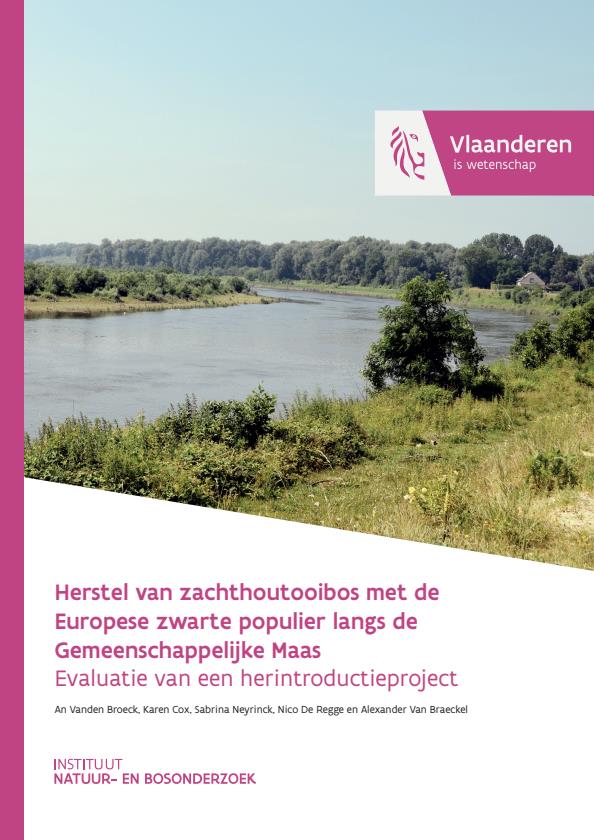Herstel van zachthoutooibos met de Europese zwarte populier langs de gemeenschappelijke Maas. Evaluatie van een herintroductieproject
Details
| Aantal pagina's | 36 |
|---|---|
| Type | Rapporten van het Instituut voor Natuur- en Bosonderzoek |
| Categorie | Onderzoek |
| Taal | Nederlands |
Bibtex
@misc{7d09a978-7ac0-407b-897a-1f8679b584ca,
title = "Herstel van zachthoutooibos met de Europese zwarte populier langs de gemeenschappelijke Maas",
abstract = "The restoration and protection of riparian forests is one of the key priorities in biodiversity conservation and climate change adaptation strategies. As a pioneer species, black poplar plays a key-role in the development of softwood forests in Europe. Unfortunately, the European black poplar is one of the most threatened tree species in Europe, mainly because of the loss of its natural alluvial habitat, especially sand and gravel banks, which allows for successful reproduction, and because of competition and introgression with exotic poplar species. Here, we report on the impact of exotic Populus taxa at the initial stages of softwood riparian forest development of the river Meuse on the Dutch-Belgian border almost two decades after reintroducing black poplar and after the re-establishment of the natural river dynamics.
A former study performed in 1999-2000 emphasized the need for planting native P. nigra since natural populations were almost gone extinct in the study area. A few isolated relict trees of European black poplar in the study area suggested the presence of natural populations in the past. In contrast to the native poplar species, plantations of cultivated poplars were common in the study area. A reintroduction project of European black poplar was performed in the period 2002-2005. European black poplar was successfully planted on two locations nearby the river; locations Groeskens and Negenoord. The aim was to create seed sources for natural regeneration and thereby to promote the colonisation of native European black poplar in newly restored habitat.
In this study, we evaluated the taxonomy of the poplar seedlings that spontaneously colonised the river banks of the Common Meuse and we determined the frequency of natural hybridization events between male cultivated poplars and the female native European black poplars in the study area. We hereto used a combination of diagnostic chloroplast and nuclear molecular markers that have been proven useful in identifying the taxonomy of Populus seedlings. We have compared the results with a similar study performed in 1999-2001 at the same site and before the restoration actions took place.
The majority (98%) of the poplar seedlings from the gravel banks analysed where identified as European black poplar. The sampled seedlings that exhibited genes of exotic poplar species were located at distances of > 1 km from the nearest reintroduction sites of black poplar. This indicates that hybrid poplars still reproduce in the study area, in particular on sites located further away from the reforestation sites of black poplar. Establishing more seed sources of black poplar over the river stretch could further reduce hybrid reproductive success along the Common Meuse.
Almost two decades after reintroducing P. nigra, the constitution of the seed and pollen pools changed in the study area in favour of reproduction of the native species and at the expense of the exotic poplar species. This study indicates that, although significant gene flow form exotic poplars is observed in European floodplains, restoration programmes of the native European black poplar can vigorously outcompete the exotic gene flows and strongly reduce the impact of exotic Populus taxa on the softwood riparian forest development.
Hundreds of young black poplar seedlings colonized the gravel banks. The survival of poplar seedlings depends on the combination of many factors broadly related to the availability of water and oxygen. Seedling survival should be monitored over large time scales to evaluate the success of this restoration project and to predict riparian forest development along the river Common Meuse.
",
author = "An Vanden Broeck and Karen Cox and Sabrina Neyrinck and Nico De Regge and Alexander Van Braeckel",
year = "2020",
month = jan,
day = "01",
doi = "https://doi.org/10.21436/inbor.18609931",
language = "Nederlands",
publisher = "Instituut voor Natuur- en Bosonderzoek",
address = "België,
type = "Other"
}

